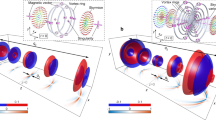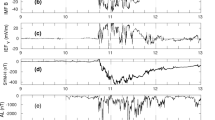Abstract
WE have recently found the most general non-static solution of spherical symmetry satisfying the relativistic equations of electromagnetism, namely, in the usual notation1. The line element is The surviving components of the tensor Tµν are four: Both Ï and ƒ(m) are arbitrary. We note that m is conserved along a line of flow.
This is a preview of subscription content, access via your institution
Access options
Subscribe to this journal
Receive 51 print issues and online access
$199.00 per year
only $3.90 per issue
Buy this article
- Purchase on SpringerLink
- Instant access to full article PDF
Prices may be subject to local taxes which are calculated during checkout
Similar content being viewed by others
References
Tolman, R. C., "Relativity, Thermodynamics and Cosmology", 259 (1934).
Vaidya, P. C., Curr. Sci., 12, 183 (1943).
Mineur, H., Ann. de l'École Normale Supérieure, Sér. 3, 5, 1 (1933).
Author information
Authors and Affiliations
Rights and permissions
About this article
Cite this article
NARLIKAR, V., VAIDYA, P. A Spherically Symmetrical Non-Static Electromagnetic Field. Nature 159, 642 (1947). https://doi.org/10.1038/159642a0
Issue date:
DOI: https://doi.org/10.1038/159642a0
This article is cited by
-
Gravitation field in the Vaidya problem allowing separation of variables in the Hamilton-Jacobi equation
Soviet Physics Journal (1986)
-
A new derivation for the field of a time-varying charge in Einstein's theory
International Journal of Theoretical Physics (1981)
-
Symmetries and the Einstein-Maxwell field equations the null field case
General Relativity and Gravitation (1976)
-
Spherically symmetric radiation of charge in Einstein-Maxwell theory
General Relativity and Gravitation (1970)
-
The gravitational field of a radiating star
Proceedings of the Indian Academy of Sciences - Section A (1951)



